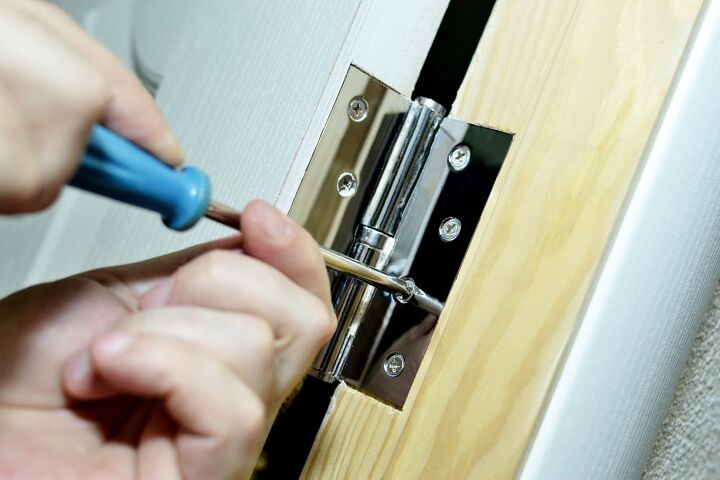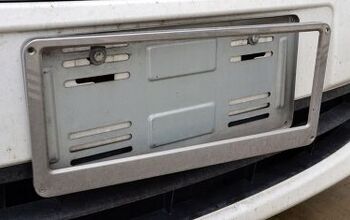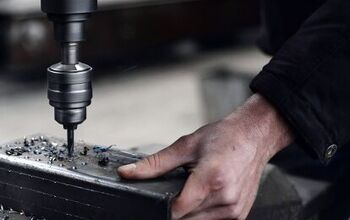What Size Screws For Door Hinges?

Door hinges are brilliant pieces of hardware that allow heavy doors to seamlessly open and close. You hardly even know they are there until one starts squeaking, or worse, comes loose. If you find yourself where a hinge has lost a screw or two, or you need to replace a hinge all together, you will need to know what size screw to use for your door hinge.
The screw size for door hinges depends on several factors. A one-inch screw works for standard light doors and cabinets, but you need a longer screw for a heavier door. You must consider the diameter of the screw, which affects its security and stability. Entrance door screws are typically #9 or #10 screws, but vary. Door size and weight also factor into the screw size needed.
As you get ready to select the right screws for your door hinge, you need to understand the size will vary based on a few factors. After all, not every door is the same, or serves that same purpose. Once you understand each of the variables and how these factor into your hinge screw size you will be ready to select the perfect screws for your project.
Why Door Hinge Screw Size Matters
When you are embarking on a mission to find the right screw for your door hinges you need to understand how the size of your screw factors into how effective it is. Screws are normally measured in two ways – by their length and their diameter. These measurements are both important.
The screw length is important as too short of a screw and it will render itself ineffective. If your screw is too long it can risk poking through the other side or jeopardizing the integrity of the wood.
The screw width is equally important. The diameter of the screw and its screw head have a strong impact on the strength of the screw. As a rule, the wider the diameter and the screw head, the more secure the screw is. This plays a role when it comes to hinges used in different types of doors.
Factors That Affect What Screws You Need For Door Hinges
There is not one universal screw used for door hinges. That is because there is not one universal door. In order to understand what hinge is best for you, you need to take the following factors into consideration.
Internal Versus External Door Hinges
What works for an inside door may not work for an exterior door. This is true for the door thickness, material, hinge and even the screws. External doors are usually much heavier than internal doors, for safety and security reasons. They are also often reinforced by a metal of some kind.
Because of these differences in external and internal doors, external door hinge screws often need to be both longer and wider.
Door Size
Door size also impacts screw size. Regardless if it is an interior or external door, a large door is likely to need a larger and wider screw. If, however, you are dealing with a small and narrow cabinet or pantry door, you will need a smaller screw. If you opt for #9 or #10 screws that are used for more exterior doors, you may damage the door. Opt for a shorter screw with a diameter that will fit comfortably in the hinge holes.
Door Weight
The weight of the door plays a major role in the size screw you need. A lighter door like a cabinet door can get away with a shorter and more narrow screw. If, however, you have a heavy door, you are likely to need a longer and thicker screw. Longer thicker screws, as a rule, provide for security and stability.
How To Measure A Hinge Screw
As you embark on the task of figuring out what size hinge screw to buy, it is a good idea to know how to measure a screw. After all, if you are replacing an existing hinge screw, you can simply measure it and know what type of screw to replace it with. At least that should work in theory.
Measuring Screw Width
A screw width is measured in a gauge. This is the number (#8, #9, etc.) that you typically find assigned to screw types. This number refers to a fraction of an inch – it is a measurement system of sorts. For example, a #0 gauge screw is 1/16 of an inch, which a #1 gauge screw is 5/64 of an inch. These are small differences, and the best way to find out the gauge of your screw is to line up your screw with a size chart.
To measure the thickness of a screw you measure from one side of a screw thread to the other side (not the internal measurement, or the measurement of the head).
Measuring Screw Length
The length of the screw is measured in inches. This makes things fairly simple, as you can simply lay down your screw against a tape measure and have the accurate length number for your next screw purchase. If you have a #8 screw that is three inches long you will look for a #8 x 3 screw.
The Best Type Of Metal For Your Door Hinges Screws
In addition to the size and type of screw you use for your door hinge, you might also wonder what type of metal is best. Just like there is not one type of screw that is always perfect, there is also not one type of metal that is perfect.
The key is to make sure the metal can endure the pressure and conditions of the given door hinge. For example, if it is a screw that will provide for an outdoor hinge, make sure the screw is a metal that is weatherproof, and ideally coated. This will prevent rust from the elements.
You should also make sure that the screw and the hinge are the same metal. While this metal will vary based on the metal used for the hinge, you should not mix metals. Many metals do not react well together, and can corrode if placed together for long periods of time.
Wrapping Up Screw Sizes For Door Hinges
When you are looking for the right screw size for your door hinges, you need to know both the ideal length and width. These measurements will vary based on the door size and weight. Internal doors usually require a more narrow gauge screw like a #8, while an external or commercial door might need a #9 or #10 screw. If possible, measure an existing hinge screw to find a suitable replacement.

Tom Gaffey is an expert writer who currently resides in Washington D.C. Tom has a passion for real estate and home improvement writing, as well as travel and lifestyle writing. He lived the last twelve years in Hawaii where he worked closely with luxury resorts and event planners, mastering his knowledge of aesthetics and luxury products. This is where he found his passion for home improvement and a keen interest in DIY projects. Currently, Tom resides in Washington D.C, and also working on his debut fiction novel.
More by Tom Gaffey



























